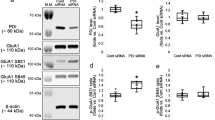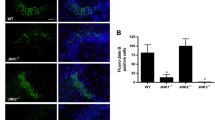Abstract
GABA is a dominant inhibitory neurotransmitter in the brain and A type GABA receptor (GABAAR) phosphorylation is critical for GABA-mediated inhibitory effect. However, its role in the neuroprotective effect of sodium valproate (VPA), a prevalent drug for treating patients with epilepsy, remains elusive. The present study was conducted to explore the role of GABAAR phosphorylation in the neuroprotection of VPA against a kainic acid-induced epileptic rat model and the potential molecular mechanisms. Neuronal apoptosis was evaluated by TUNEL assay, PI/Annexin V double staining, caspase-3 activity detection and Bax and Bcl-2 proteins expression via Western blot analysis. The primary rat hippocampal neurons were cultivated and cell viability was measured by CCK8 detection following KA- or free Mg2+-induced neuronal impairment. Our results found that VPA treatment significantly reduced neuronal apoptosis in the KA-induced rat model (including reductions of TUNEL-positive cells, caspase-3 activity and Bax protein expression, and increase of Bcl-2 protein level). In the in vitro experiments, VPA at the concentration of 1 mM for 24 h also increased cell survival and suppressed cell apoptosis in KA- or no Mg2+-induced models via CCK8 assay and PI/Annexin V double staining, respectively. What is more important, the phosphorylation of γ2 subunit at serine 327 residue for GABAAR was found to be robustly enhanced both in the KA-induced epileptic rat model and neuronal cultures following KA exposure after VPA treatment, while no evident alteration was found in terms of GABAAR β3 phosphorylation (408 or 409 serine residue). Additionally, pharmacological inhibition of protein kinase C (PKC) clearly abrogated the neuroprotective potential of VPA against KA- or free Mg2+-associated neuronal injury, indicating a critical role of PKC in the effect of GABAAR γ2 serine 327 phosphorylation in VPA’s protection. In summary, our work reveals that VPA mitigates neuronal apoptosis in KA-triggered epileptic seizures, at least, via augmenting PKC-dependent GABAAR γ2 phosphorylation at serine 327 residue.






Similar content being viewed by others
References
Guerrini R, Parmeggiani L (2006) Topiramate and its clinical applications in epilepsy. Expert Opin Pharmacother 7:811–823
Lopez-Santiago LF, Yuan Y, Wagnon JL, Hull JM, Frasier CR, O’Malley HA, Meisler MH, Isom LL (2017) Neuronal hyperexcitability in a mouse model of SCN8A epileptic encephalopathy. Proc Natl Acad Sci USA 114:2383–2388
Staley K (2015) Molecular mechanisms of epilepsy. Nat Neurosci 18:367–372
Loscher W, Schmidt D (1980) Increase of human plasma GABA by sodium valproate. Epilepsia 21:611–615
Macdonald RL, Olsen RW (1994) GABAA receptor channels. Annu Rev Neurosci 17:569–602
Mao X, Ji C, Sun C, Cao D, Ma P, Ji Z, Cao F, Min D, Li S, Cai J, Cao Y (2012) Topiramate attenuates cerebral ischemia/reperfusion injury in gerbils via activating GABAergic signaling and inhibiting astrogliosis. Neurochem Int 60:39–46
Gunther U, Benson J, Benke D, Fritschy JM, Reyes G, Knoflach F, Crestani F, Aguzzi A, Arigoni M, Lang Y, Bluethmann H, Mohler H, Luscher B (1995) Benzodiazepine-insensitive mice generated by targeted disruption of the gamma 2 subunit gene of gamma-aminobutyric acid type A receptors. Proc Natl Acad Sci USA 92:7749–7753
Essrich C, Lorez M, Benson JA, Fritschy JM, Luscher B (1998) Postsynaptic clustering of major GABAA receptor subtypes requires the gamma 2 subunit and gephyrin. Nat Neurosci 1:563–571
Kittler JT, Moss SJ (2003) Modulation of GABAA receptor activity by phosphorylation and receptor trafficking: implications for the efficacy of synaptic inhibition. Curr Opin Neurobiol 13:341–347
Vithlani M, Moss SJ (2009) The role of GABAAR phosphorylation in the construction of inhibitory synapses and the efficacy of neuronal inhibition. Biochem Soc Trans 37:1355–1358
Tretter V, Revilla-Sanchez R, Houston C, Terunuma M, Havekes R, Florian C, Jurd R, Vithlani M, Michels G, Couve A, Sieghart W, Brandon N, Abel T, Smart TG, Moss SJ (2009) Deficits in spatial memory correlate with modified {gamma}-aminobutyric acid type A receptor tyrosine phosphorylation in the hippocampus. Proc Natl Acad Sci USA 106:20039–20044
Muir J, Arancibia-Carcamo IL, MacAskill AF, Smith KR, Griffin LD, Kittler JT (2010) NMDA receptors regulate GABAA receptor lateral mobility and clustering at inhibitory synapses through serine 327 on the gamma2 subunit. Proc Natl Acad Sci USA 107:16679–16684
Hunter T (1995) Protein kinases and phosphatases: the yin and yang of protein phosphorylation and signaling. Cell 80:225–236
Moss SJ, Doherty CA, Huganir RL (1992) Identification of the cAMP-dependent protein kinase and protein kinase C phosphorylation sites within the major intracellular domains of the beta 1, gamma 2S, and gamma 2L subunits of the gamma-aminobutyric acid type A receptor. J Biol Chem 267:14470–14476
Pose-Utrilla J, Garcia-Guerra L, Del Puerto A, Martin A, Jurado-Arjona J, De Leon-Reyes NS, Gamir-Morralla A, Serrano AS, Garcia-Gallo M, Kremer L, Fielitz J, Ireson C, Perez-Alvarez MJ, Ferrer I, Hernandez F, Avila J, Lasa M, Campanero MR, Iglesias T (2017) Excitotoxic inactivation of constitutive oxidative stress detoxification pathway in neurons can be rescued by PKD1. Nat Commun 8:2275
Racine RJ (1972) Modification of seizure activity by electrical stimulation. II. Motor seizure. Electroencephalogr Clin Neurophysiol 32:281–294
Duan B, Wang YZ, Yang T, Chu XP, Yu Y, Huang Y, Cao H, Hansen J, Simon RP, Zhu MX, Xiong ZG, Xu TL (2011) Extracellular spermine exacerbates ischemic neuronal injury through sensitization of ASIC1a channels to extracellular acidosis. J Neurosci 31:2101–2112
Garrido JL, Godoy JA, Alvarez A, Bronfman M, Inestrosa NC (2002) Protein kinase C inhibits amyloid beta peptide neurotoxicity by acting on members of the Wnt pathway. FASEB J 16:1982–1984
Ji Y, Pang PT, Feng L, Lu B (2005) Cyclic AMP controls BDNF-induced TrkB phosphorylation and dendritic spine formation in mature hippocampal neurons. Nat Neurosci 8:164–172
Ninan I, Arancio O (2004) Presynaptic CaMKII is necessary for synaptic plasticity in cultured hippocampal neurons. Neuron 42:129–141
Xie Y, Kang R, Sun X, Zhong M, Huang J, Klionsky DJ, Tang D (2015) Posttranslational modification of autophagy-related proteins in macroautophagy. Autophagy 11:28–45
Gjertsen BT, Doskeland SO (1995) Protein phosphorylation in apoptosis. Biochim Biophys Acta 1269:187–199
Zheng P, Shultz SR, Hovens CM, Velakoulis D, Jones NC, O’Brien TJ (2014) Hyperphosphorylated tau is implicated in acquired epilepsy and neuropsychiatric comorbidities. Mol Neurobiol 49:1532–1539
Takagi N (2014) Protein tyrosine phosphorylation in the ischemic brain. J Pharmacol Sci 125:333–339
Kumar P, Jha NK, Jha SK, Ramani K, Ambasta RK (2015) Tau phosphorylation, molecular chaperones, and ubiquitin E3 ligase: clinical relevance in Alzheimer’s disease. J Alzheimers Dis 43:341–361
Zhang X, Shi M, Ye R, Wang W, Liu X, Zhang G, Han J, Zhang Y, Wang B, Zhao J, Hui J, Xiong L, Zhao G (2014) Ginsenoside Rd attenuates tau protein phosphorylation via the PI3K/AKT/GSK-3beta pathway after transient forebrain ischemia. Neurochem Res 39:1363–1373
Hashimoto R, Hough C, Nakazawa T, Yamamoto T, Chuang DM (2002) Lithium protection against glutamate excitotoxicity in rat cerebral cortical neurons: involvement of NMDA receptor inhibition possibly by decreasing NR2B tyrosine phosphorylation. J Neurochem 80:589–597
Lopes MW, Lopes SC, Costa AP, Goncalves FM, Rieger DK, Peres TV, Eyng H, Prediger RD, Diaz AP, Nunes JC, Walz R, Leal RB (2015) Region-specific alterations of AMPA receptor phosphorylation and signaling pathways in the pilocarpine model of epilepsy. Neurochem Int 87:22–33
Lopes MW, Soares FM, de Mello N, Nunes JC, Cajado AG, de Brito D, de Cordova FM, da Cunha RM, Walz R, Leal RB (2013) Time-dependent modulation of AMPA receptor phosphorylation and mRNA expression of NMDA receptors and glial glutamate transporters in the rat hippocampus and cerebral cortex in a pilocarpine model of epilepsy. Exp Brain Res 226:153–163
Wang A, Chi Z, Wang S, Sun Q (2009) Calcineurin-mediated GABA(A) receptor dephosphorylation in rats after kainic acid-induced status epilepticus. Seizure 18:519–523
Sanchez RM, Dai W, Levada RE, Lippman JJ, Jensen FE (2005) AMPA/kainate receptor-mediated downregulation of GABAergic synaptic transmission by calcineurin after seizures in the developing rat brain. J Neurosci 25:3442–3451
Chen LL, Wang YB, Song JX, Deng WK, Lu JH, Ma LL, Yang CB, Li M, Xue Y (2017) Phosphoproteome-based kinase activity profiling reveals the critical role of MAP2K2 and PLK1 in neuronal autophagy. Autophagy 13:1969–1980
Seeburg DP, Feliu-Mojer M, Gaiottino J, Pak DT, Sheng M (2008) Critical role of CDK5 and Polo-like kinase 2 in homeostatic synaptic plasticity during elevated activity. Neuron 58:571–583
Shekarabi M, Zhang J, Khanna AR, Ellison DH, Delpire E, Kahle KT (2017) WNK kinase signaling in ion homeostasis and human disease. Cell Metab 25:285–299
Zhao H, Nepomuceno R, Gao X, Foley LM, Wang S, Begum G, Zhu W, Pigott VM, Falgoust LM, Kahle KT, Yang SS, Lin SH, Alper SL, Hitchens TK, Hu S, Zhang Z, Sun D (2017) Deletion of the WNK3-SPAK kinase complex in mice improves radiographic and clinical outcomes in malignant cerebral edema after ischemic stroke. J Cereb Blood Flow Metab 37:550–563
Zhang J, Gao G, Begum G, Wang J, Khanna AR, Shmukler BE, Daubner GM, de Los Heros P, Davies P, Varghese J, Bhuiyan MI, Duan J, Duran D, Alper SL, Sun D, Elledge SJ, Alessi DR, Kahle KT (2016) Functional kinomics establishes a critical node of volume-sensitive cation-Cl(-) cotransporter regulation in the mammalian brain. Sci Rep 6:35986
Okuno S, Saito A, Hayashi T, Chan PH (2004) The c-Jun N-terminal protein kinase signaling pathway mediates Bax activation and subsequent neuronal apoptosis through interaction with Bim after transient focal cerebral ischemia. J Neurosci 24:7879–7887
Lopes MW, Soares FM, de Mello N, Nunes JC, de Cordova FM, Walz R, Leal RB (2012) Time-dependent modulation of mitogen activated protein kinases and AKT in rat hippocampus and cortex in the pilocarpine model of epilepsy. Neurochem Res 37:1868–1878
Acknowledgements
Our present work was financially supported by National Natural Science Foundation of China (Nos. 81302750, 81671293 and 81503073), Clinical Research Fund of Peking University Unamed-Central South University Xiangya Hospital (No. xywm 2015I16), Natural Science Foundation of Hunan Province (No. 2017JJ3479) and Open Foundation of Innovative Platform in Colleges and University of Hunan Province of China ([2015]54).
Author information
Authors and Affiliations
Corresponding author
Ethics declarations
Conflict of interest
We declared no potential financial conflict of interest.
Ethical Approval
Fifty Sprague–Dawley rats were used in our present investigation and randomly divided into each group. Efforts were made to minimize animal suffering and the number of animals. Throughout the investigation, all procedures involving animals were in strict accordance with the guidelines established by the Animal Care Committee of Central South University.
Rights and permissions
About this article
Cite this article
Li, Q., Li, QQ., Jia, JN. et al. Sodium Valproate Ameliorates Neuronal Apoptosis in a Kainic Acid Model of Epilepsy via Enhancing PKC-Dependent GABAAR γ2 Serine 327 Phosphorylation. Neurochem Res 43, 2343–2352 (2018). https://doi.org/10.1007/s11064-018-2659-8
Received:
Revised:
Accepted:
Published:
Issue Date:
DOI: https://doi.org/10.1007/s11064-018-2659-8




